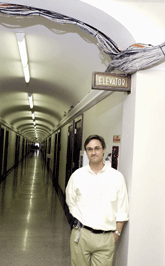Bayard Whitmore knows that the jumble of wires and cables where the wall meets the ceiling might be unsightly, but it serves its purpose.This particular jumble, at the archway in the third-floor hall of the General Services Administration's 1917 building at 18th and F streets Northwest in Washington, carries the agency's data and telecommunications.But Whitmore, an architect in the GSA Public Buildings Service's Center for Historical Buildings, wants the best of both worlds: IT functionality that doesn't interfere with the aesthetic appeal of the architecture.It's a common challenge in Washington, where agencies try to deliver e-government from historic buildings, some of which date to the days of powdered wigs. These structures were built to last, but not necessarily to support Gigabit Ethernet.To keep his hopes up, all Whitmore has to do is look around Washington to see many old buildings that have had modern technology assimilated into their historic features. Where once drop ceilings and Sheetrock may have been good enough, officials now realize the importance of preserving an architectural heritage.One example is the Environmental Protection Agency complex, which includes three venerable office buildings, the Greek-style National Archives and Records Administration headquarters on Pennsylvania Avenue and several offices on Capitol Hill.Many federal buildings are undergoing complete renovations, incorporating telecommunications, wireless and broadband technologies into the offices in a smarter, more flexible way. And just as important, where Whitmore is concerned, architects and IT mangers are paying greater attention to aesthetics as they integrate technology.'We have to make a conscious effort to come up with an office design that is aesthetically appealing to federal tenants but also keeps the historical integrity of the building,' Whitmore said. 'It comes down to a successful blend of new and old.'GSA manages all executive branch buildings and federal courthouses across the country, including 409 historic facilities built between 1810 and 1952.The Architect of the Capitol runs most other historic buildings in Washington, the oldest of which were constructed in 1793.Agencies must receive approval from different layers of government before renovating any historical building. First, they must receive support from the Office of Management and Budget and funding from Congress. Then, officials must gain consent from the D.C. State Historical Preservation Commission and the National Capital Planning Commission for any internal and external changes to the building. Finally, the U.S. Commission on Fine Arts must approve any internal changes.All of the buildings have been updated numerous times with modern conveniences such as air conditioning, analog'and later digital'phone lines and sprinkler systems. GSA and the Architect of the Capitol are constantly upgrading the buildings to handle the technological needs of today and tomorrow.[IMGCAP(2)] Pat Alexander, the renovation project manager at NARA, said the agency is upgrading its electrical, telecommunications and data capacity to last the agency another 30 years. The agency currently needs 500 phone lines for employees, but its telecommunications system can support 900 lines.Alexander said NARA's architectural and construction teams had to overcome several challenges. Employees had to remain in the building during reconstruction. The blueprints from previous renovations did not match, and planners wanted to keep the historical features of the 75-year-old building intact.Alexander's first task was to keep the antique moldings along the outer edges of the ceilings in place. Working with general contractor Grunley Construction Co. Inc. of Rockville, Md., Alexander devised a plan to run cable and network wires to offices by cutting away the center of the hallway ceiling, leaving the historic plaster moldings in place. The contractor installed a cable tray in the groove to run telecommunications and high-speed Internet cables for each office, and then replastered and painted the ceiling.'It is easy to replicate the rest of the work on the ceiling, but not the edges,' he said. 'Previously, we ran all cables and wires along the surface of the building, along baseboards, and used drop ceilings or wire molding to cover them up.'Alexander also had to determine which among multiple architectural drawings was accurate. Workers found unexpected support beams that were not in the drawings, which made snaking wire through the walls more difficult.'We had to cut holes in walls without historical significance so you could see what was inside,' he said.Having multiple, unmatched blueprints of historic federal buildings is a common challenge for architects and construction companies, said Scott Teixeira, project architect of NARA's renovation for Hartman-Cox Architects of Washington.Teixeira said workers were surprised to find a conduit for electrical wires running between the floor tiles and a concrete slab five inches below the floor level. The electrical contractor, Singleton Electric Co. of Gaithersburg, Md., used the channel to run wires and cabling through some of the historical parts of the building.At GSA, Whitmore said he would like to see all external wires hidden under raised floors or hung in the ceiling on cable trays. In the architect's office, for instance, contractors installed a sloped ceiling to handle the wiring, sprinkler piping and other modern systems when GSA renovated the office.'We also built drywall around columns to drop the telecommunications structure through,' Whitmore said. 'We were able to keep the historic corridors intact while modernizing the office space.'EPA's architects had an easier time with the agency's three-building complex. They demolished all recent internal partitions, while keeping the historic archways and hall ceilings.Bruce Riddle, an EPA telecommunications specialist, said the challenge was running wires through the ceiling to the offices on the other side of the telecommunications closets.In some cases, workers had to run wire from the floor below to reach the office, Riddle said.'We stacked the telecommunications rooms on each floor, so all cabling goes straight up throughout the building,' he said. 'But that also caused challenges to get the wiring to the other office across the hall. We had to bring in professional plasterers from Europe to fix the ceiling.'With all the challenges architects, construction workers and IT managers found in wiring old buildings, you might think wireless systems would be an obvious solution. But officials found it tough to transmit wireless signals through the ancient, 24- to 30-inch-thick walls, Riddle said.EPA architects and IT managers had to design a wireless system that provided cell phone coverage and WiFi access by hanging antennas from ceilings in two or three offices per floor.At the Library of Congress' Thomas Jefferson Building, built in 1897, contractor EMS Technologies of Atlanta had to be creative. Brian Wheeler, application, engineering and sales manger for EMS, said workers hid antennas behind false walls or in unused heating ducts.EMS also put antennas in the basement to transmit signals up into the building through its marble floors, he said. Many of the thick plaster walls have wire mesh or iron beams for support, which interferes with phones and notebook PCs trying to pick up wireless signals.'The older buildings are constructed like fortresses,' Wheeler said. 'The more obstructions there are, like thick walls, the more antennas you have to put in to get coverage.'Teixeira said that, too often, agencies and companies renovate old buildings in the cheapest and easiest way, which covers up most of their historic characteristics.'The way we did the NARA building is the way we thought the original architect would have wanted it done,' he said. 'All the new systems that are needed in buildings will impact them, the goal is to do it invisibly and correctly.'
NARA's Pat Alexander indicates how cables were routed from a wiring closet to offices across the hall without destroying historic plaster moldings.
Rachael Golden
GSA architect Bayard Whitmore knows that bunches of wires creeping along the ceiling are unsightly. He hopes the agency can make its older buildings look better while accommodating new technology.
Henrik G. de Gyor








